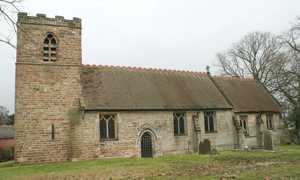 ThrumptonAll SaintsNottingham Archdeaconry West Bingham Deanery Introduction
Thrumpton, then known as Termodestun, appears in the Domesday Records. Formerly
owned by Danish Mercians by the names of Leofwine and Alnoth the lands were,
by 1086, in the hands of a Norman, Roger de Bully although both William Peverell
and Hugh de Grandmesnil had interests in various parcels of land.
Before that Termodestun
was on a minor Roman road from Derby to Willoughby which crossed the Trent
at Trent Shallows. There was, therefore,
likely to have been a significant amount of traffic and travellers seeking
to cross the river. No records exist of an Anglo-Saxon church.
Later, in medieval
times, Thrumpton Hall became the seat of the Powdrells
and on their fall from grace, the Pigotts. They
in turn became impoverished and the lordship of the manor was sold to the Emmerton-Wescomb
family in the 17th Century and thence came into the possession of Lucy Wescomb.
Lucy became Lady Byron through her first marriage. Thrumpton Hall then
passed to her nephew, Charles, the 10th Lord Byron (who also became rector
of Thrumpton).
Each
of the lords of the manor had a say in the church affairs and left their
mark on the fabric. The church was altered several times,
the last being in 1870, which
work was commissioned and directed by Lucy Wescomb (Lady Byron).
The village grew in size based
on agriculture and the management of the Hall. Gypsum mining was carried out
and a plaster mill was built here on the banks of the Trent. The village
is now largely residential.
The village has an 18th Century
Church House next to the churchyard which was given by Lady Byron as a vicarage.
Particular thanks to John Allen and Ray State for research
on this entry
|